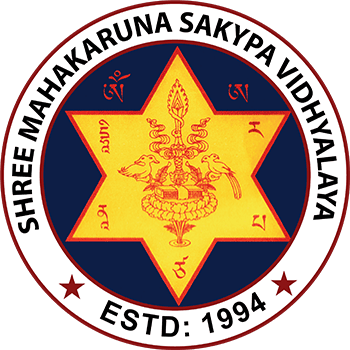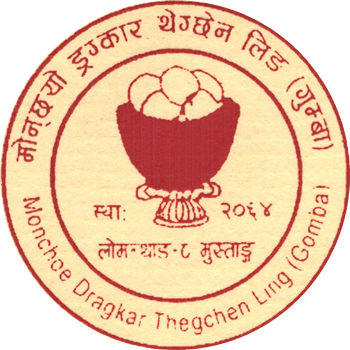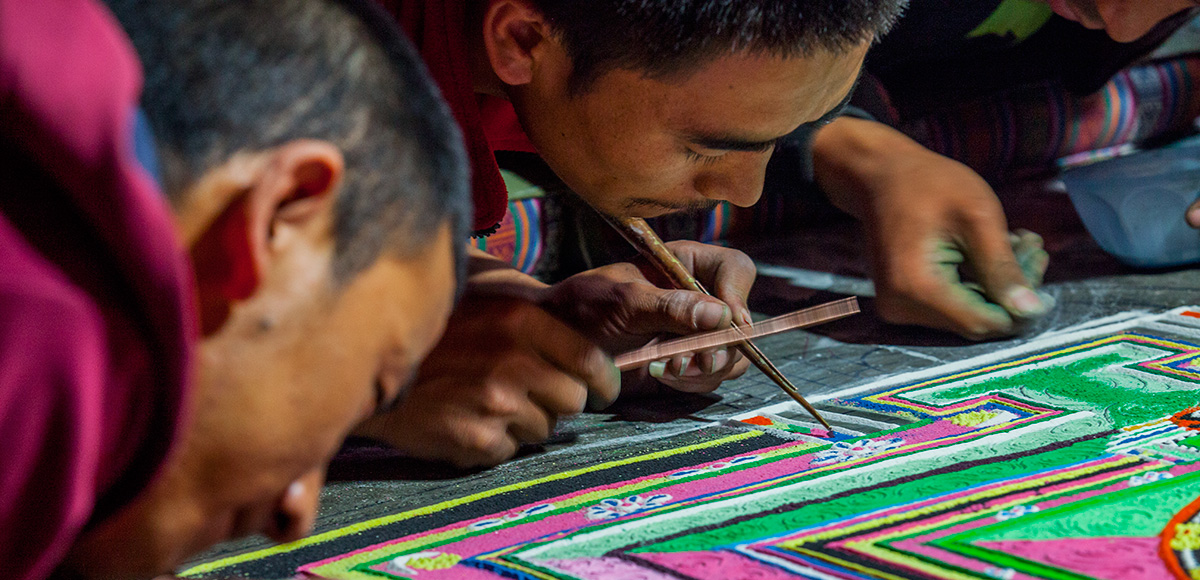PHUR-DRUB/ Vajrakilaya Sand Mandala Ritual
Monchoe monastery performs innumerable rituals in the annual lunar calendar based on the Sakya tradition of Tibetan Buddhism and Phur-drub/ Vajrakilaya ritual is one of the most elaborate. The Vajrakilaya ceremony is held in the seventh Tibetan lunar month in the shrine hall of Thubchen Lhakhang. In fact, people often refer to the Vajrakilaya ritual as Dunba, or ‘the seventh’, and it’s a week-long ritual practice.
The reason why Vajrakilaya ritual is performed in the Sakya tradition is to commemorate one of the preceding Sakya throne holder Ngagchang Kunga Rinchen’s noble activities. The great master revived and re-established the whole system when the Sakya order was in a degenerative state. Since that time, the Vajrakilaya ritual has been performed during the seventh month to commemorate and repay the kindness of the holy master who worked so tirelessly to revive the order.
The Vajrakilaya ritual begins with a very elaborate dance to bless the earth and related earth rituals. After that a sand mandala is created, and the Vajra master and monks incorporate the sand mandala into the ritual practice every day and receive self-empowerment from it.
The seventy-five kilaya, (ritual pegs or stakes) that are part of the Vajrakilaya ritual mandala must be made according to exact specifications. This is an important aspect of the ritual.
Finally, the sand mandala is dismantled in a very elaborate and grand ritual during which time the deity Vajrakilaya appears in wrathful form as the manifestation of all the Buddhas' activities to subdue obstacles. It is believed that by participating in the ritual, all obstacles for the entire year will be cleared away and the Sangha of Monchoe monastery accepts responsibility of this highly important activity in a close knit, spiritual community. Therefore, the locals come to seek audience of the mandala and therefor receive the blessings of being present during the ritual.
Uniqueness of Vajrakilaya Ritual
Many Buddhist of different traditions greatly praise the Vajrakilaya cycle for different reasons. The Vajrakilaya ritual is unique because the hereditary lineage of the Khon family, who spearhead the Sakya order of Tibetan Buddhism and the teaching lineage of the ritual go almost hand-in-hand. In addition, this lineage has been unbroken since the time of Padmasambhava and Khon Nagendra Raksita, right up until the present. Also, through the centuries, the unbroken series of Vajrakilaya lineage holders have all had very high realization, due to which almost every single one of them performed great miracles.
The Ritual Examination: Study and Performance of the Ritual
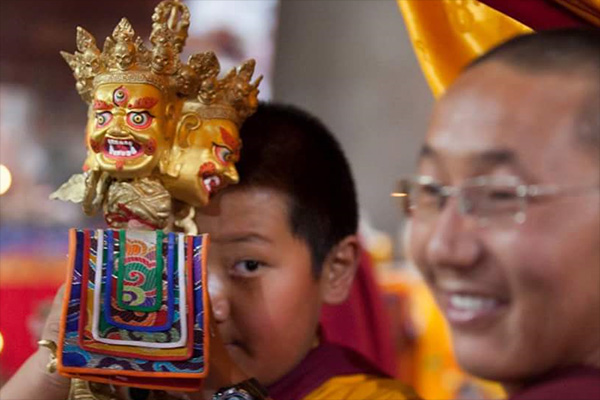 The annual ceremony has incorporated a very important and demanding examination for monks wishing to demonstrate their mastery of the ritual curriculum. After several years’ progressive study of scriptures along with secondary level of general studies at the monastic school, the novice monks are eligible to sit for this major ritual prayer examination. Part of the examination requires a different student each day to serve as chant master. The candidate is required to lead the chanting of the ritual without using a text. In one of the most complex sections of the ritual, a text may be used, although doing so results in a loss of five points. Passing this important examination is the gateway to further study and training in all aspects of advanced ritual practice. Unless a monk passes this Vajrakilaya examination, they do not receive further ritual training and their tasks in the monastery are allocated accordingly.
The annual ceremony has incorporated a very important and demanding examination for monks wishing to demonstrate their mastery of the ritual curriculum. After several years’ progressive study of scriptures along with secondary level of general studies at the monastic school, the novice monks are eligible to sit for this major ritual prayer examination. Part of the examination requires a different student each day to serve as chant master. The candidate is required to lead the chanting of the ritual without using a text. In one of the most complex sections of the ritual, a text may be used, although doing so results in a loss of five points. Passing this important examination is the gateway to further study and training in all aspects of advanced ritual practice. Unless a monk passes this Vajrakilaya examination, they do not receive further ritual training and their tasks in the monastery are allocated accordingly.
The Experience of Attending the Vajrakilaya Ritual
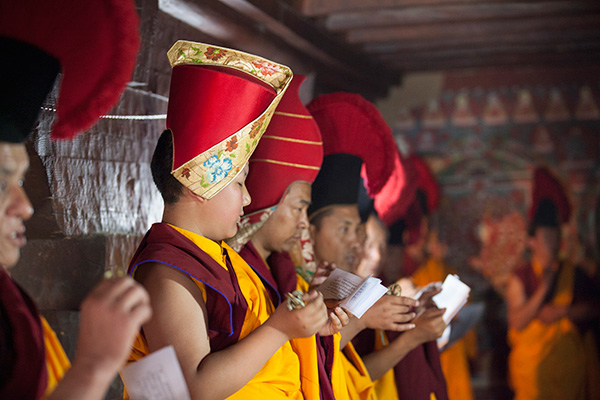 During most of the week ritual, there are only a handful of lay people who attend for an entire day although the general population enters Thubchen monastery briefly to receive blessings. However, on the last day, locals attend to mark to completion of a sacred ritual activity by receiving blessings of the dismantled sand mandala at the city gate in the evening. For a lay observer, the Vajrakilaya grand ritual is truly a varied, exciting, virtuous religious event from the point of view of both drama and spiritual energy. All of this is combined in the single-minded evocation of the blessings and protection of Vajrakilaya upon all sentient beings and the taming of all forces that need to be tamed.
During most of the week ritual, there are only a handful of lay people who attend for an entire day although the general population enters Thubchen monastery briefly to receive blessings. However, on the last day, locals attend to mark to completion of a sacred ritual activity by receiving blessings of the dismantled sand mandala at the city gate in the evening. For a lay observer, the Vajrakilaya grand ritual is truly a varied, exciting, virtuous religious event from the point of view of both drama and spiritual energy. All of this is combined in the single-minded evocation of the blessings and protection of Vajrakilaya upon all sentient beings and the taming of all forces that need to be tamed.
The music is extensive and varied, including a range of sacred instruments. Performing them requires years of dedicated practice by the monks.
Sacred wind instruments include the long horn (Dungchen), which is generally only used in the more wrathful higher Vajrayana practices; the Tibetan oboe (Gyaling), which carries intricate melodies; and conch shells (dung), some with and some without elaborate decorations. These wind instruments require the players to have mastered a very difficult circular breathing technique which provides long periods of continuous and unceasing melody without pause for breath. The music also includes thigh-bone trumpets (Kangling) which are accompanied by the swirling of silk cloths, and are played to welcome the deities.
The drums come in three sizes: two very large ones and many smaller ones. Other percussion instruments include large and small cymbals (Rolmo and Silnyen). These are played continuously for long periods of time, which requires considerable strength and stamina in the players’ arms and hands.
All of these instruments combine with a wide variety of chanting in various tunes, which creates a stunning richness and variety that becomes spiritually overwhelming at certain points in the ritual. When the full orchestra of sacred instruments and the chanting of monks is joined by the long horns blasting forth with their deep vibrating resonance, the sound pervades and blesses every pore of one’s being.
The Vajrakilaya ritual is truly a wondrous and blessed event. It is inspiring to think of the authenticity of the empowerment and teachings upon which this is based, maintenance of the vows through the centuries, the years of study that are required by every master and practitioners who performs the ritual, the mastery of the instruments, creation of the monastic environment, and offering of the resources that makes each year’s performance possible. These blessings have been preserved and transmitted continuously for every sentient being to receive the blessings of the continuation of the authentic practice lineage of the holy Dharma.
